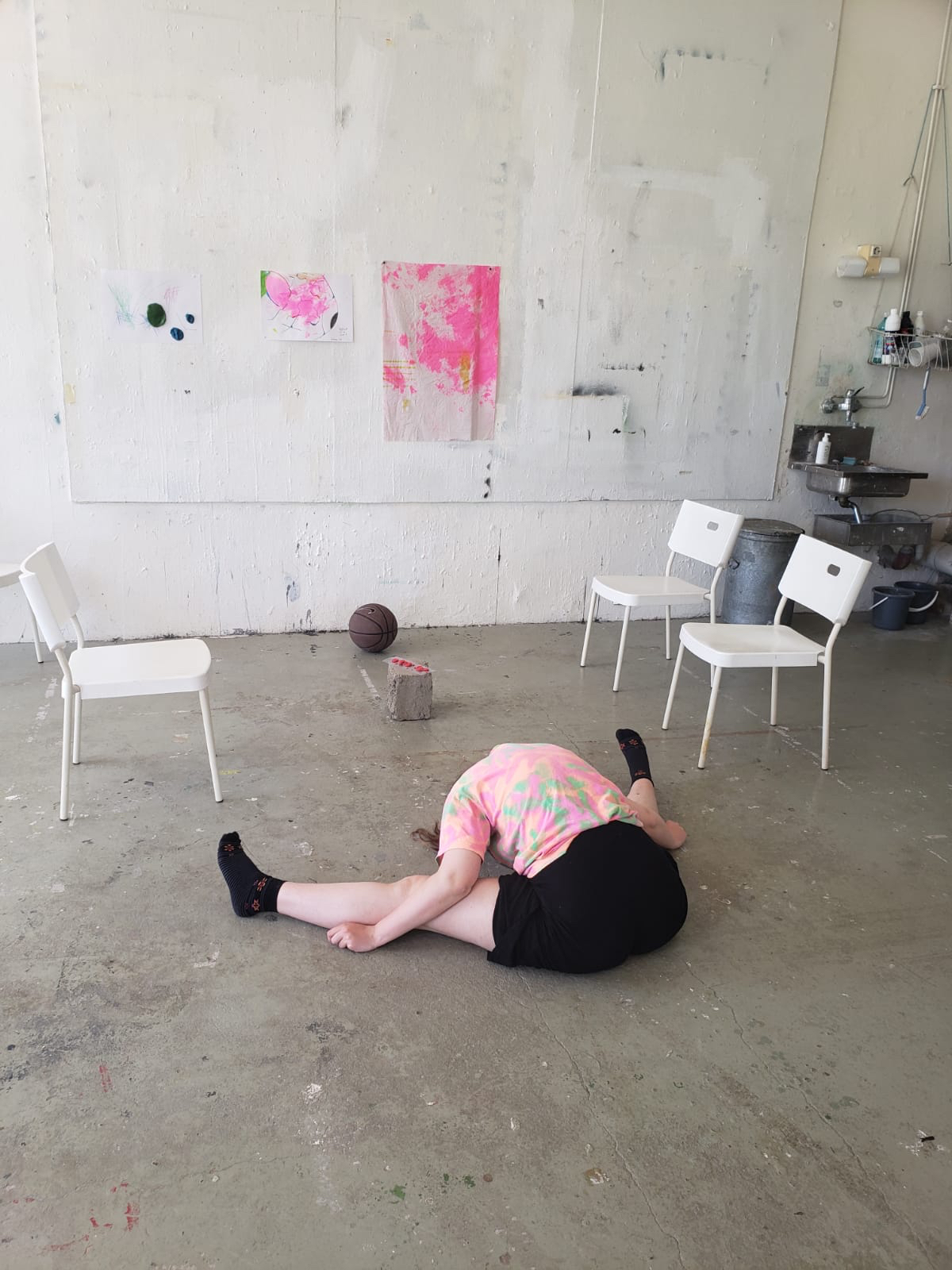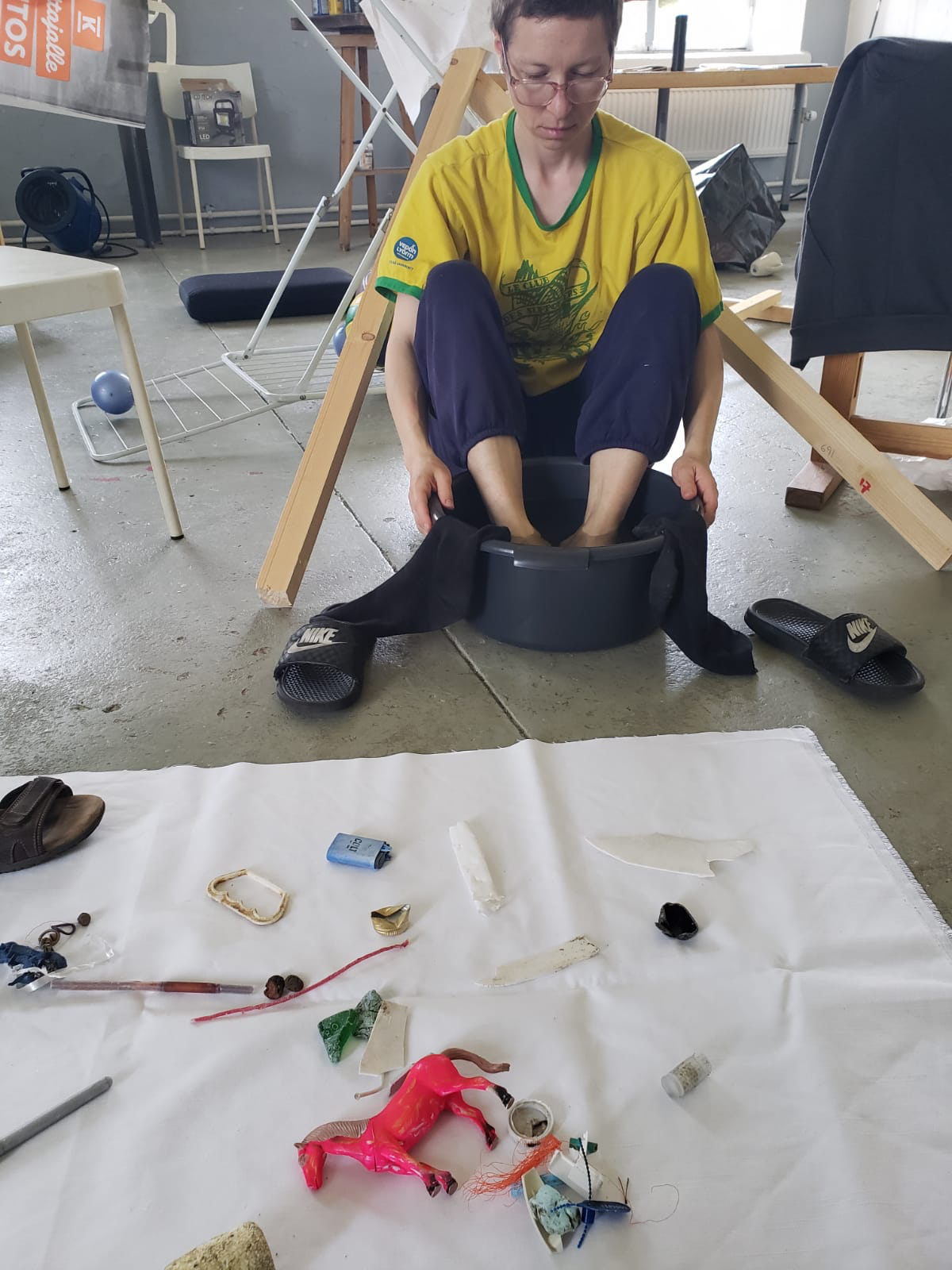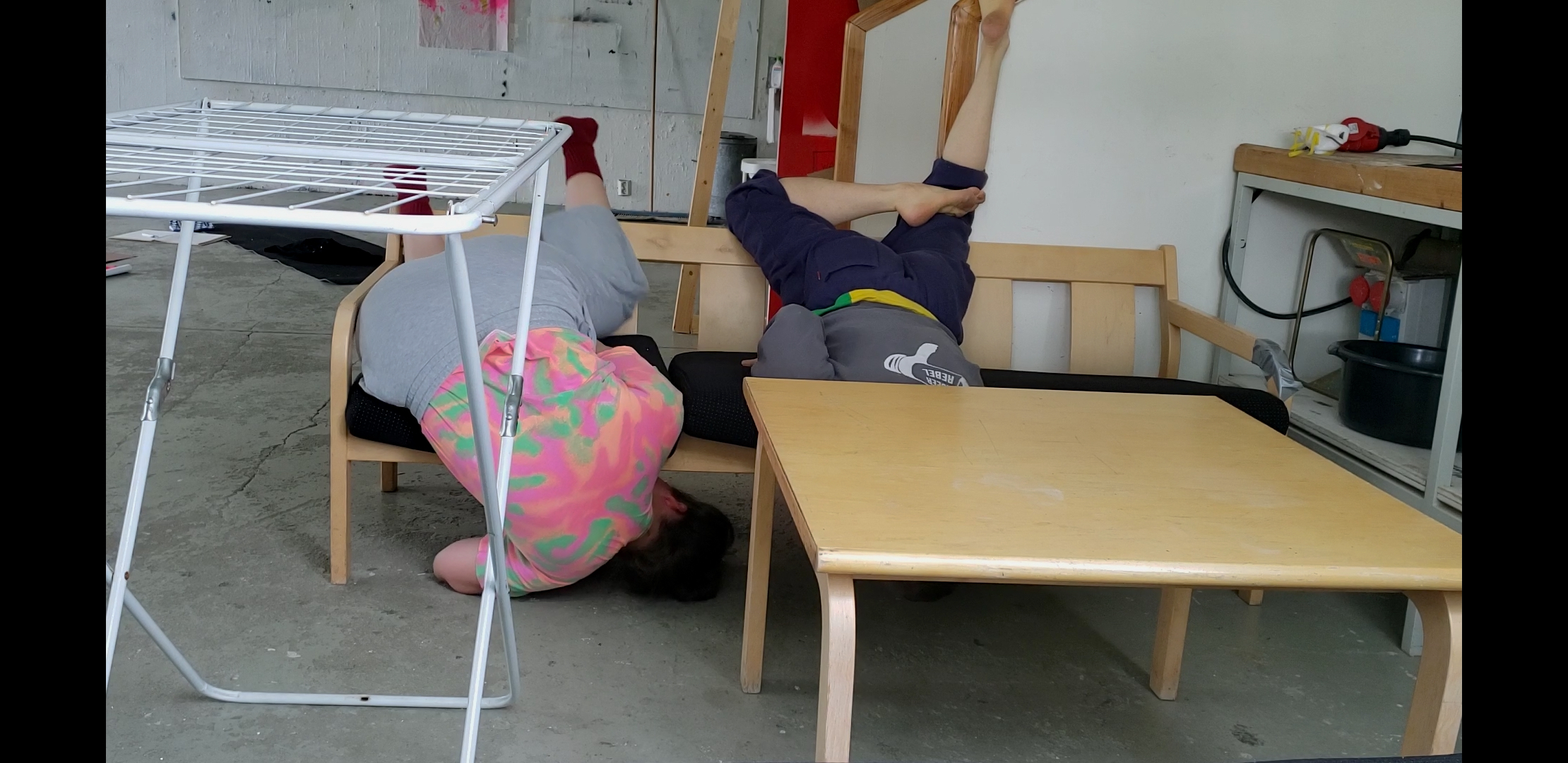30 Jul 2020
Interview
DASHA CHE & SUVI TUOMINEN: SINKING THROUGH MOVEMENT
Performance artist duo Dasha Che and Suvi Tuominen are two of the Finland-based artists who were selected for a summertime residency at HIAP’s Suomenlinna studios in 2020. Dasha and Suvi have backgrounds in archaeology and queer activism, as well as dance and performance art. During their residency they are exploring concepts of sinking, procrastination, drifting and withdrawal.

Performance practice at HIAP studio. Photo: Dasha Che.
AA: You currently work as a performance artist duo. How did this all start? How did you meet?
DC & ST: We met as first year students of the Live Art & Performance Studies master’s programme at the University of the Arts in Helsinki. We both had a dance background and were concerned with the corporeal presence within our highly theoretical and conceptual program. We resonated both in our search for a body and the bodily connections with its surroundings and other human and non-human presences. We shared different types of bodily practices every day in between classes, such as touching, massaging, stretching, breathing and so on. This made it possible for us to approach our readings with our bodies and connect with different types of texts on a tissue level. We started meeting for a regular improvisation practice in November 2019 and, immediately, our duet work felt playful and provocative. So, we pursued it further by starting to work on a performance and looking for opportunities.
DC: As a queer non-binary educator and organizer who has worked in the art activism field in the USA, Russia and recently, Finland for several years, I was interested in exploring less certain and direct places of bodies entanglements, power dynamic and objectification. Perhaps, artistically I was ready to stay with the discomfort of not knowing, not getting answers, drifting and sinking, attending to several layers that different meta-objects produce in practice, such as political repressions, structural discrimination, and other horrific effects of neoliberal capitalism with more reflexive distance. I was personally fascinated by Suvi’s attentive and ethical performance work with objects as archaeological matter whether those were the newly found things such as a bundle of plastic strings or archaic findings. As a trained archeologist Suvi has an acute sensitivity and aesthetical leaning toward residue and drifting objects, as a performer and a dance artist Suvi is concerned with body ecologies and presences. Almost right away it felt like Suvi and I were echoing each other in our solo works and thinking.
ST: As a dancer and an archaeologist I was very curious about the different ways in which Dasha approached material culture, objects and artefacts with performance. Dasha has arrived in Helsinki from such a different ecology, history and background. Personally, I found this fascinating in terms of pointing differences and perspectives in our thinking, but also as a challenge to trace for similarities in our practices. The rich and multifaceted dimension of Dasha’s history both in dance and queer activism intrigued me and I wanted to learn from them, step into a different understanding of socio-political realities and the ways in which they affect bodies and practices in different contexts. When I saw some of Dasha’s works during our studies I also connected with the aesthetics that their work was luring in. It felt like a kind of invitation to step into a place of destabilisation and an unstable plane in the world of objects. Dasha approaches and treats objects with care and love, recognising differences in such a nuanced way, and yet, they does allow objects to go, not get attached or try to capture/preserve. To me this was the mode in which we could also discuss deeply the ethics of our mutual practice, and also the ways in which it connects with radical archaeological thinking.
AA: You have backgrounds in archaeology and queer activism, as well as dance and performance art. In terms of physically creating, what did you find as the connection points?
DC & ST: We both come from hard-working, rigorous environments, moreover, the last year left us breathless and exhausted. Yet, we love taking naps and resting as a part of our practice or improvisational scores. During our rehearsals we put the pleasure and care elements forward – the work environment doesn’t have to be stressful, oppressive and miserable to remain professional. When we physically create, the connection point starts from the body and becomes movement. After discussing chaotically different types of themes for a few hours we usually might stretch first, find the support of the floor, quiver, re-organise the furniture in the room, and listen to all kinds of music. After that we start working with different types of performance scores and perform for each other. In these moments we connect with the choreographic thinking and research material for future performances. We think that this way of working is a kind of destabilisation of the aesthetic process and a search for something that we might not directly comprehend or recognise. In this sense, we resist creating performance strategies beforehand, but rather think of our practices as moments of arrival to ‘new’ art objects.
On a discursive level we usually go off on tangents, constantly reflect our concepts and doings, are critical toward our own processes, and try to find holes where the body is placed. But also as artists we demand from ourselves to face the contested question around aesthetics and form, the plane, which is sometimes viewed in opposition to content and ideas. The main connection point in our thinking is our interest in objects, objects as humans, humans as objects, and the ‘unknowable’realms of how bodies yield with/within matter. And yet always something remains withdrawn, doesn’t add up, does not make sense in a ‘relational’ world. This highly difficult and complex ontological question is something we deal with every day as a sort of ‘’theory arousal’’.
In our professional thinking we converge on the notion that different opinions about different matters can be present in the practice and in the discussions. To the very end we avoid conformism and turning our artistic practice into some kind of ideology, despite having strong personal socio-political views. The richness in our collaboration is in having very different connection points with previous thinkers, artists, practitioners and so on.

Tub, things, splashes at HIAP studio. Photo: Suvi Tuominen.
AA: During your HIAP residency you are exploring sinking as a carnal mode of resistance in the time of neoliberal work conditions. Procrastination is usually talked about as something that needs to be overcome and turned into something productive. What a refreshing idea, to think of it as valuable in itself, not through some productive outcome. Can you tell us a bit more about your ideas and current explorations?
DC & ST: As artists we have experienced a lot of pressure, external and internal demands to show up and produce, to constantly respond to global and local events with an art work. This got intensified during the COVID19 pandemic, where various institutions and entities of power pressured artists to come up with responses to self-isolation and fear, and basically produce the whole culture for online platforms. It felt that art was yet again instrumentalized as something that helped people to cope with the mental and emotional distress. We continued our practice outdoors during the pandemic, while discussing the origins and directions of this pressure to produce. Our main question turned out to be that where is the body of the artist placed in all this pressure? Procrastination for us is about entering the withdrawn, horizontal and carnal body on a very intimate level (even to the extent that we often share our toilet stories and poop in front of each other). Whereas, production to us is turbulent, vertical and usually social to the extent that the carnal body is missing. Also rethorics such as ‘’artists are going to innovate alternative futures around the climate crisis’’ or ‘’art will imagine better futures’’ is something that we consider to be the rhetoric of neoliberal capitalism, making artists compete against each other. Those who have the best and boldest idea or appearance win the lottery. Strategizing and future chasing rethorics is something we discuss as chronological capitalism. We do not wish to give in to this rethorics in our practice and, therefore, this HIAP residency has been extremely important for us to be able to conceptualize this concern we have and work deeply with our bodies without strategies and productivity pressure. Time at HIAP residency has enabled us to think of counter practices and postures in the time of neoliberal work conditions. These practices help us to orientate our bodies differently in the arts and other practices we currently do, such as activism and archaeology.
DC: Our duet started with posing a question, how can we not move toward active artwork production once more, but rather, remain in a curious and not so precious space of a pre-practice where we can give up, step out, re-enter, doubt ourselves, and let the censorship inner guards go. I personally was curious whether my artistic response to oppressive systems and horrors of injustice also can be a withdrawal as much as the act of showing up, stepping forward and fighting.
ST: As an archaeologist I always end up doubting chronological time. After all, time is an abstraction that matter and objects convey and bring forth. For example, an iPhone and a prehistoric arrowhead exist in the same time plane as my body. So, what if alternative futures would be conceptualised as alternative pasts, multiplicity of present or in between?
AA: As performance and dance artists, how are you thinking of performing this sinking, this withdrawal, through movement?
DC & ST: Sinking, withdrawal and procrastination as concepts are important for our practice. We think of these concepts as modes of resisting strategies and the type of productivity it brings. We practice qualities of sinking through the aforementioned naps-taking, horizontal positions, breathing, gravity-sinking to the floor and so on. However, in the performance work we try to be open to the ways in which matter, whether it is images, movement, objects or other entities, comes into play along with these concepts of sinking and withdrawal. The performance and the performance thinking operate with a very different modality than our conceptual reasoning of the practice. This also feels ethical somehow, in the sense that the performing emerges from the affectual and material, and, perhaps, also from the withdrawn qualities of the medium that we are connected to such as dance, performance, visual art or filmmaking. We believe that a certain amount of distancing is needed in order for art to become public. We read a lot of philosophical texts and scientific articles but we do not wish our work to become a representation of those thoughts or an attempt to represent. We notice that the carnal body is yet again missing from this equation, while the body remains the most critical thing in our artistic practice.
AA: How much of your work is improvised? In what ways does the audience affect the performance?
DC & ST: Our practice often happens in between the actual rehearsal times. We spontaneously share thoughts, quotes from the texts we are interested in, images, events that we are a part of, larger issues that we have feelings about. This communication does not feel pressured, but rather, flows and feeds us both artistically and intellectually, feels like an ongoing improvising. Therefore, when we enter the rehearsal space, even when it looks empty, it feels charged with floating ideas, questions and affects. Our job for the rehearsal is to catch these entanglements of matter and keep moving in the rich assemblage. We often work with performance scores, and if we find something interesting, we start to engage our choreographic thinking inviting the repetition and patterns in. Repetition usually brings forth a notion of qualities, foci and differences in movement and performing. Yet, we still leave a lot of space for improvisation and rambling. For the performance we make choices with a certain level of commitment yet we want for the messy entanglements that appeared at the initial stage to remain present as well, so our performance work does not look complete or polished somehow. We want the glimpses of doubt, uncertainty and confusion keep coming through.
When it comes to the audience we work differently in different settings, sometimes the audience is in a more active role of a participant, other times we are curious what the passive spectatorship could do in relation to all the elements that are engaged in the event. This time in our HIAP upcoming performances the audience is invited to stay more in the mode of voyeurism in our art studio which is full of things that we keep reassembling during our practices. For us different types of performance spaces call for different types of spectator relationalities in the space. We can adjust to a black box, to a site situated performance, to a studio space, or gallery space. In this way we work with spaces in a very fluid manner. The space performs as much as we do and we try to remain aware of that.

Sinking practice on a sofa at HIAP studio. Photo: Samsung Galaxy S7.
AA: What else are you currently working on and what you are looking forward to this year in terms of upcoming exhibitions and events?
DC & ST: Our time at the HIAP residency will translate into different types of events in August, such as an open studio session at our HIAP studio in Suomenlinna on the 15th and 16th of August, a performance-lecture and a workshop at UrbanApa festival in Ateneum on the 22nd of August and two site situated performances happenings in Kalasatama and Jätkäsaari on the 23rd of August. On top of this, we are organising and performing at an international Live Art and Performance festival called Lapsody as part of our studies between 15-18 of September. Also, both of us have many individual projects and other collaborations that we work with, so ironically, we are both very productive. However, the shift that has happened during the HIAP residency in the body is going to make a huge difference in how to approach work. With a sinking, withdrawing and horizontal body.
DC: In my personal work I have been collaborating with artists of different disciplines over the last spring and summer as well as working on individual artistic practices. I have just worked on a duo called “Something We Love Very Slowly” with Francisco Trento, an artist and a researcher of neurodiverse and queer practices in academia, connecting to daily surrounding objects through intimacy and playfulness. I intend to continue this practice writing about it and documenting it through various mediums. Together with Vishnu Vardhani, a performance artist and a body philosopher, I have been co-facilitating an ongoing transnational reading group where we both focus on the texts by philosophers of color and share our own artistic practices in relation to the readings. Also, I am, together with two other dancers, working with Minna Karttunen, a Finnish choreographer and a contemporary dancer, on their project called Home Findings which will be performed at UrbanApa festival this August. Additionally, I have a solo dance piece that I have been working on called “Future Parts: What Happens When It Stops,” which first was performed last February and is coming back this September.
ST: This year I am looking forward to different events, collaborations, conferences and performances. I have been working with curator Riikka Thitz with notions on deep time, geological processes and landscape dramaturgy that will actualise in the form of several performances in August. I am also part of the European Association of Archaeologists virtual conference in August in a session called Speculative Archaeology: Creating Methodologies, where I will speak of performance, fictioning and archaeology. I am also working with two solo projects this year, one circulating around video art and one with archival practices. On top of this I am looking forward to continuing my studies in the Live Art and Performance Studies programme and meeting all my colleagues and teachers there.
Photos provided by the artists.
Read more:
